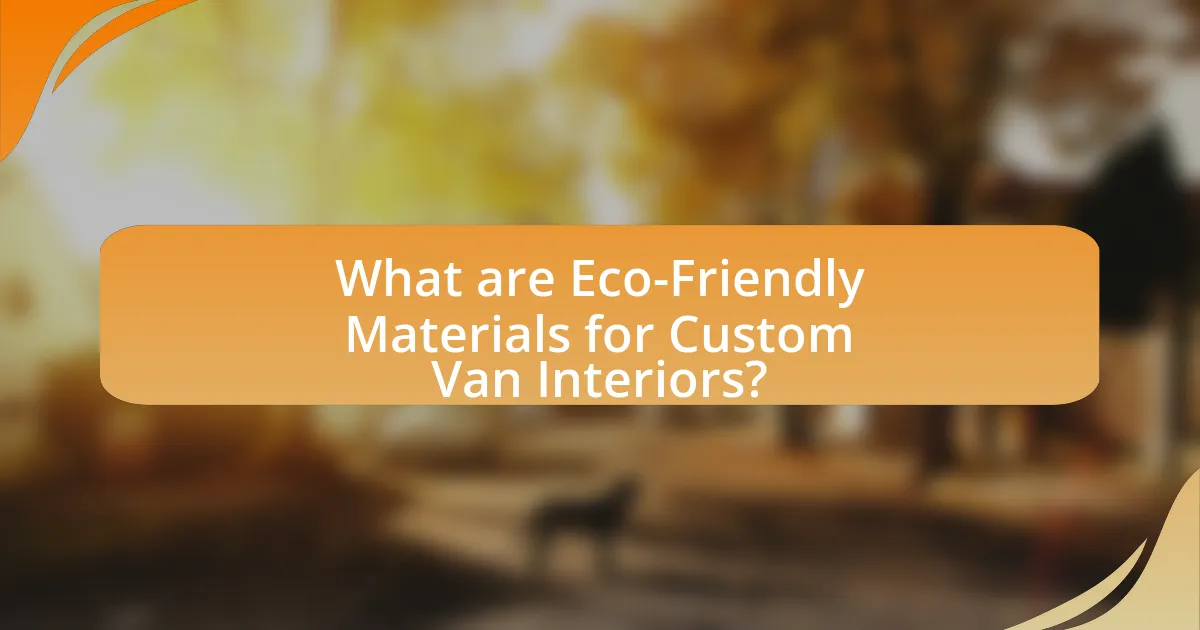Eco-friendly materials for custom van interiors include bamboo, recycled plastics, organic cotton, cork, and natural wool, each offering unique benefits such as sustainability, durability, and aesthetic appeal. The article emphasizes the importance of using these materials to reduce environmental impact, enhance indoor air quality, and promote resource conservation. It discusses the characteristics and advantages of each material, the challenges associated with sourcing them, and best practices for maintenance to ensure longevity. Additionally, the article highlights how eco-friendly materials can improve the design and functionality of van interiors while appealing to environmentally conscious consumers.

What are Eco-Friendly Materials for Custom Van Interiors?
Eco-friendly materials for custom van interiors include bamboo, recycled plastics, organic cotton, cork, and natural wool. Bamboo is a rapidly renewable resource that offers durability and aesthetic appeal, while recycled plastics help reduce waste and can be molded into various shapes for interior design. Organic cotton is grown without harmful pesticides, making it a safe choice for upholstery, and cork, harvested from the bark of cork oak trees, is sustainable and provides excellent insulation. Natural wool is biodegradable and offers thermal regulation, enhancing comfort within the van. These materials collectively contribute to a sustainable and environmentally friendly van interior design.
Why is it important to use eco-friendly materials in van interiors?
Using eco-friendly materials in van interiors is important because they reduce environmental impact and promote sustainability. Eco-friendly materials, such as bamboo, recycled plastics, and organic fabrics, minimize harmful emissions and waste during production and disposal. For instance, using recycled materials can significantly lower carbon footprints; a study by the Environmental Protection Agency indicates that recycling one ton of plastic can save 7.4 cubic yards of landfill space and reduce greenhouse gas emissions by 3,000 pounds. Additionally, eco-friendly materials often enhance indoor air quality by reducing volatile organic compounds (VOCs), which are common in conventional materials. This contributes to a healthier living environment for occupants.
What environmental benefits do eco-friendly materials provide?
Eco-friendly materials provide significant environmental benefits by reducing pollution and conserving natural resources. These materials often come from renewable sources, which minimizes the depletion of finite resources. For instance, bamboo, a common eco-friendly material, grows rapidly and can be harvested sustainably, leading to lower carbon emissions compared to traditional timber. Additionally, eco-friendly materials typically involve less energy-intensive manufacturing processes, which further decreases greenhouse gas emissions. Studies indicate that using recycled materials can save up to 95% of the energy required to produce new materials, thereby significantly lowering the overall environmental impact.
How do eco-friendly materials contribute to sustainability in van customization?
Eco-friendly materials significantly enhance sustainability in van customization by reducing environmental impact and promoting resource conservation. These materials, such as bamboo, recycled plastics, and organic fabrics, minimize the carbon footprint associated with production and disposal. For instance, using recycled aluminum for van components can save up to 95% of the energy required to produce new aluminum, thereby conserving natural resources and reducing greenhouse gas emissions. Additionally, eco-friendly materials often come from renewable sources, ensuring that the customization process supports sustainable practices and reduces reliance on finite resources. This shift towards sustainable materials not only benefits the environment but also appeals to consumers increasingly concerned about ecological footprints in their purchasing decisions.
What types of eco-friendly materials are commonly used in custom van interiors?
Eco-friendly materials commonly used in custom van interiors include bamboo, recycled plastics, organic cotton, and cork. Bamboo is favored for its rapid growth and sustainability, making it a strong and lightweight option for cabinetry and flooring. Recycled plastics are utilized in upholstery and paneling, reducing waste and promoting circular economy practices. Organic cotton is often chosen for cushions and bedding due to its non-toxic cultivation methods, which minimize environmental impact. Cork, harvested from the bark of cork oak trees, is valued for its durability and insulation properties, making it suitable for flooring and wall coverings. These materials collectively contribute to a more sustainable and environmentally friendly van interior design.
What are the characteristics of bamboo as an eco-friendly material?
Bamboo is a highly sustainable and eco-friendly material characterized by its rapid growth, strength, and biodegradability. It can grow up to 91 centimeters in a single day, making it one of the fastest-growing plants on Earth, which allows for quick harvesting without depleting resources. Bamboo has a high tensile strength, comparable to steel, which makes it durable for various applications, including construction and furniture. Additionally, bamboo is biodegradable, meaning it can decompose naturally without harming the environment, unlike synthetic materials that contribute to pollution. These characteristics make bamboo an ideal choice for eco-friendly materials in custom van interiors, promoting sustainability while providing functional benefits.
How does recycled plastic serve as a sustainable option for van interiors?
Recycled plastic serves as a sustainable option for van interiors by reducing waste and minimizing the demand for virgin materials. Utilizing recycled plastic diverts significant amounts of plastic waste from landfills, with estimates indicating that recycling one ton of plastic can save approximately 7.4 cubic yards of landfill space. Additionally, the production of recycled plastic requires less energy compared to new plastic, leading to lower greenhouse gas emissions. For instance, using recycled PET (rPET) can reduce energy consumption by up to 66% compared to producing new PET. This makes recycled plastic not only an environmentally friendly choice but also a practical one for creating durable and lightweight van interiors.
How do eco-friendly materials impact the design and functionality of van interiors?
Eco-friendly materials significantly enhance the design and functionality of van interiors by promoting sustainability while offering aesthetic and practical benefits. These materials, such as bamboo, recycled plastics, and organic fabrics, contribute to a healthier living environment by reducing harmful emissions and allergens. For instance, using low-VOC (volatile organic compounds) paints and finishes improves indoor air quality, making the space more comfortable for occupants. Additionally, eco-friendly materials often possess durability and lightweight properties, which can improve fuel efficiency and ease of installation. Research indicates that incorporating sustainable materials can also increase the resale value of vehicles, as consumers increasingly prioritize eco-conscious choices.
What aesthetic advantages do eco-friendly materials offer?
Eco-friendly materials offer aesthetic advantages such as natural beauty, unique textures, and a warm, inviting appearance. These materials often feature organic patterns and colors that enhance the visual appeal of custom van interiors, creating a more harmonious and calming environment. For instance, reclaimed wood provides a rustic charm, while bamboo offers a sleek, modern look. Additionally, eco-friendly fabrics like organic cotton and hemp come in a variety of colors and patterns, allowing for personalized design choices that align with sustainable practices. This combination of visual appeal and sustainability attracts consumers who value both aesthetics and environmental responsibility.
How do these materials affect the durability and maintenance of van interiors?
Eco-friendly materials enhance the durability and reduce the maintenance needs of van interiors. These materials, such as recycled plastics, bamboo, and organic fabrics, are often more resistant to wear and tear compared to traditional materials. For instance, recycled plastics can withstand moisture and UV exposure, preventing deterioration over time. Additionally, organic fabrics are typically treated with natural finishes that resist stains and odors, making cleaning easier and less frequent. Studies indicate that using such sustainable materials can extend the lifespan of van interiors by up to 30%, thereby reducing the need for replacements and repairs.
What challenges are associated with using eco-friendly materials in custom van interiors?
Using eco-friendly materials in custom van interiors presents several challenges, including higher costs, limited availability, and potential durability issues. The higher costs arise because sustainable materials often require more expensive sourcing and processing methods compared to conventional materials. Limited availability can hinder customization options, as not all eco-friendly materials are widely produced or distributed. Additionally, some eco-friendly materials may not offer the same level of durability or performance as traditional materials, leading to concerns about longevity and maintenance. These factors collectively complicate the design and implementation of eco-friendly interiors in custom vans.
What are the cost implications of choosing eco-friendly materials?
Choosing eco-friendly materials often results in higher initial costs compared to conventional materials. This is primarily due to the sourcing of sustainable resources, which can be more expensive to produce and process. For instance, organic cotton or bamboo may have a higher price point than synthetic alternatives because of the farming practices and certifications required. Additionally, eco-friendly materials may require specialized manufacturing processes that can increase production costs. However, these materials can lead to long-term savings through durability, energy efficiency, and reduced environmental impact, which can offset the initial investment over time.
How can one overcome sourcing difficulties for eco-friendly materials?
To overcome sourcing difficulties for eco-friendly materials, one can establish partnerships with specialized suppliers who focus on sustainable products. These suppliers often have established networks and can provide access to a wider range of eco-friendly materials, such as recycled fabrics or sustainably sourced wood. Research indicates that companies prioritizing sustainability in their supply chains can enhance their material sourcing efficiency by up to 30%, as reported in the “Sustainable Supply Chain Management” study by the Journal of Cleaner Production. Additionally, utilizing online platforms dedicated to sustainable materials can streamline the sourcing process, allowing for easier comparison and selection of eco-friendly options.
How can one effectively incorporate eco-friendly materials into a custom van interior design?
To effectively incorporate eco-friendly materials into a custom van interior design, one should prioritize sustainable options such as bamboo, reclaimed wood, and recycled fabrics. Bamboo is a rapidly renewable resource that offers durability and aesthetic appeal, making it ideal for cabinetry and flooring. Reclaimed wood not only reduces waste but also adds character to the interior, while recycled fabrics can be used for upholstery and curtains, minimizing environmental impact. According to the Environmental Protection Agency, using reclaimed materials can significantly lower carbon footprints associated with new material production. By selecting these materials, designers can create a stylish and environmentally responsible van interior.
What design tips can enhance the use of eco-friendly materials?
To enhance the use of eco-friendly materials in custom van interiors, designers should prioritize material selection, ensuring they choose sustainable options such as bamboo, recycled metals, and organic fabrics. These materials not only reduce environmental impact but also offer durability and aesthetic appeal. For instance, bamboo is known for its rapid growth and renewability, making it a superior choice for cabinetry and flooring. Additionally, incorporating modular designs can maximize the use of eco-friendly materials by allowing for easy replacement and upgrades without waste. Research indicates that using recycled materials can significantly lower carbon footprints, with studies showing that recycled aluminum saves 95% of the energy required to produce new aluminum. Thus, focusing on sustainable sourcing and modularity can effectively enhance the use of eco-friendly materials in van interiors.
How can one ensure a cohesive look while using various eco-friendly materials?
To ensure a cohesive look while using various eco-friendly materials, one should select a unified color palette and consistent textures across all materials. This approach creates visual harmony, as colors that complement each other and similar textures help to tie different elements together. For instance, using shades of green and brown can evoke a natural aesthetic, while maintaining a similar finish, such as matte or glossy, across materials enhances the overall design. Studies in design psychology indicate that cohesive color schemes can significantly improve the perception of space, making it feel more integrated and intentional.
What are the best practices for maintaining eco-friendly materials in van interiors?
The best practices for maintaining eco-friendly materials in van interiors include regular cleaning with non-toxic, biodegradable products, ensuring proper ventilation to prevent moisture buildup, and using protective coatings that are environmentally friendly. Regular cleaning with non-toxic products helps preserve the integrity of materials like bamboo, cork, or recycled fabrics, which are commonly used in eco-friendly interiors. Proper ventilation reduces the risk of mold and mildew, which can damage these materials over time. Additionally, applying protective coatings that are eco-friendly can enhance durability without compromising the environmental benefits of the materials. These practices ensure longevity and sustainability of the eco-friendly materials used in van interiors.
How can regular maintenance extend the life of eco-friendly materials?
Regular maintenance can significantly extend the life of eco-friendly materials by preventing degradation and preserving their structural integrity. For instance, routine cleaning and care can remove dirt, moisture, and contaminants that may cause wear or damage over time. Additionally, applying protective coatings or treatments can enhance resistance to environmental factors such as UV exposure and humidity, which are known to deteriorate materials. Research indicates that materials like bamboo and recycled plastics, commonly used in eco-friendly interiors, can last longer when maintained properly, as they are less susceptible to mold and fading when kept clean and dry.
What cleaning products are safe for eco-friendly materials in van interiors?
Safe cleaning products for eco-friendly materials in van interiors include vinegar, baking soda, and castile soap. These products are non-toxic and biodegradable, making them suitable for materials like natural fibers, wood, and eco-friendly upholstery. For instance, vinegar effectively removes stains and odors without harming the environment, while baking soda acts as a gentle abrasive for scrubbing surfaces. Castile soap, derived from vegetable oils, is safe for cleaning various surfaces without leaving harmful residues. Using these products ensures the maintenance of eco-friendly materials while minimizing environmental impact.



